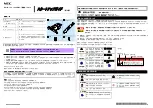
3. CONFIGURING YOUR SCSI CARD
DC-395 Series User’s Manual
17
17
IDE HDD 1
none
None
Drive D:
SCSI Device 0
Drive C:
Drive D:
(*)
SCSI Device 1
Drive D:
(*)
(*)
*
Number of drives supported by CMOS (2) has been reached. Device driver must be used
for this device.
Case 0:
No IDE drives. Two SCSI drives can be controlled with BIOS INT 13H.
Case 1:
One IDE drive is installed as drive C:. One SCSI drive can be controlled
through BIOS INT 13H.
Case 2:
Two IDE drives are installed as C: and D:. Since the maximum number of
drives supported by the CMOS (2) has been reached, no more SCSI device
can be controlled by BIOS INT 13H.
Removable media as BIOS device:
Disabled/Boot drive only/All devices.
A
BIOS device
here is a device that can be controlled via BIOS INT 13H, meaning that it
does not need a device driver and can be bootable. However, when used as a BIOS device,
the full removability of removable media devices is not preserved. The following constraints
apply:
a) The Device can only work as a fixed disk, i.e. media change is not allowed.
b) The Media must be inserted before the system boots-up.
c) Only media with
512
Bytes/sector is supported.
Disabled
If this option is disabled, the removable media devices will not be used as
BIOS devices.
Boot drive
only
(default)
This setting allows only the removable media installed as Drive C: to
work as a BIOS device, thereby allowing it to boot. As stated above, this
device would function as a hard drive, not a removable. However,
installing the provided device driver on this bootable drive would enable
full removability for other removable media devices installed.
All Disks
Enables all removable disk drives to work as BIOS devices. Enable
More
than 2 drives support
if necessary.
Note1:
Generally, unless a Removable device is to be used as a boot drive, this setting
should be kept at its default, and the driver TRMDISK.SYS should be used to
control removable devices.
Note2:
For a removable media device to boot properly, you’ll have to use DOS FDISK
partitioning utility and FORMAT it under DOS with the /S switch. Win95’s
FORMAT will treat the removable media as a Super Floppy, i.e., with no partition
table, and thus the disk will not be bootable.
















































